What Is the Car Arrow Symbol Meaning?
The arrow symbol on a vehicle's dashboard indicates the direction indicator, essential for signaling turns and lane changes. This symbol alerts other drivers and pedestrians of the vehicle's intentions.
Common issues with this system include burnt-out bulbs, wiring faults, and defective flasher relays. Immediate action is necessary to address these problems to avoid potential risks.
Diagnostic tools like OBD-II scanners and multimeters are imperative for identifying the root cause. Regular maintenance such as tire rotations and brake inspections can prevent indicator malfunctions.
Continued exploration will reveal more on efficient diagnostics and preventative measures.
Key Takeaways
- The arrow symbol on a car's dashboard indicates the direction indicator for turning or lane changes.
- It alerts other drivers and pedestrians of the vehicle's intended movement to the left or right.
- Common issues include burnt-out bulbs, wiring faults, or defective flasher relays affecting the arrow symbol function.
- Immediate action is necessary if the arrow symbol also indicates critical issues like low tire pressure or engine overheating.
- Regular maintenance and professional diagnostics can prevent and resolve issues related to the arrow symbol on the dashboard.
What the Symbol Represents
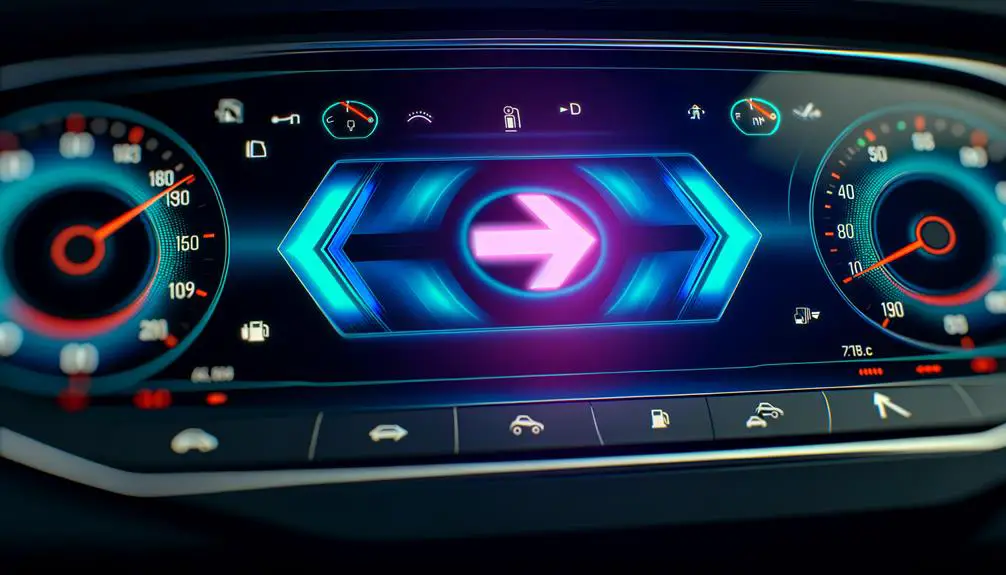
The arrow symbol on a car's dashboard typically represents the direction indicator, essential for signaling turns and lane changes. This icon is pivotal to vehicular communication, alerting other drivers and pedestrians of the vehicle's intended movements.
The dashboard display often includes separate indicators for left and right turns, usually denoted by corresponding leftward or rightward arrows. These indicators are activated via the turn signal lever, which engages the appropriate electrical circuits to illuminate the arrow and corresponding exterior lights.
Modern vehicles may also include additional functionalities, such as lane change assist or automatic turn signal cancellation, which further enhance the utility and safety of the direction indicator system. Understanding this symbol is fundamental for safe and effective driving.
Common Causes
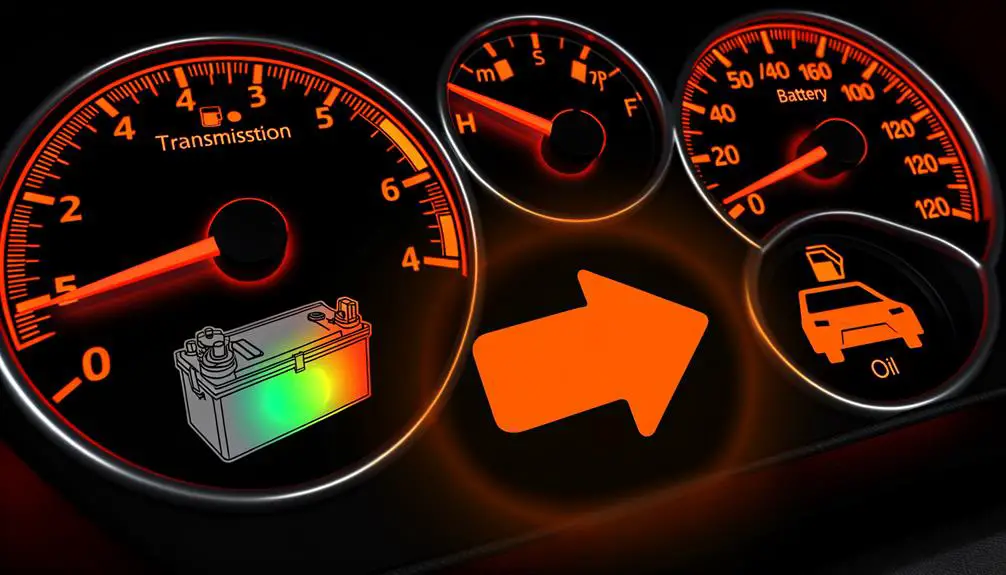
Understanding the functionality of the direction indicator system is essential to identify common causes of malfunction or failure in the arrow symbol's operation on the dashboard. One prevalent issue is a burnt-out bulb, which disrupts the electrical circuit and prevents proper signaling.
Wiring faults, such as frayed or corroded connections, can also impede signal transmission. Additionally, a defective flasher relay can result in irregular blinking or complete non-functionality.
Furthermore, issues within the dashboard's electrical components, including faulty circuit boards or damaged indicator lights, may cause the arrow symbol to malfunction. Finally, software glitches in the vehicle's electronic control unit (ECU) could lead to erroneous display or failure of the arrow symbol.
Identifying these causes is vital for timely resolution.
When to Take Action

Recognizing when to take action upon seeing the car with arrow symbol is vital for ensuring vehicle safety and functionality.
Immediate response is often required to mitigate potential risks such as mechanical failures or compromised system performance.
In such instances, seeking professional assistance is essential to accurately diagnose and address the underlying issues.
Immediate Response Required
When the car's dashboard displays an arrow symbol, it is important to determine the urgency of the situation to guarantee immediate and appropriate action. Recognizing the specific context in which this symbol appears can prevent potential mechanical failures and secure safety.
Immediate response is necessary if the arrow symbol indicates:
- Low tire pressure: Promptly check and inflate tires to the recommended PSI.
- Engine overheating: Stop the vehicle immediately, allow it to cool, and check coolant levels.
- Brake system alert: Inspect brake fluid levels and brake pad conditions.
- Transmission issues: Address any transmission warning to avoid severe damage.
- Battery charge warning: Assess the battery and charging system to prevent power loss.
Understanding these indicators secures timely maintenance and mitigates risk.
Potential Risks Involved
Frequently, the appearance of an arrow symbol on the dashboard signifies underlying issues that, if overlooked, could escalate into severe mechanical failures or safety hazards. This symbol often indicates problems related to the transmission system or critical fluid levels, such as engine oil or coolant.
Ignoring these warnings can lead to overheating, loss of power, or even catastrophic engine damage. Additionally, compromised transmission performance can result in erratic gear shifts, reduced fuel efficiency, and potential drivability issues.
Timely intervention is essential to mitigate these risks. Monitoring vehicle diagnostics through onboard systems and addressing anomalies promptly can prevent costly repairs and ensure peak vehicle operation. Understanding the implications of the arrow symbol is vital for maintaining vehicular integrity and safety.
Professional Assistance Needed
Prompt and informed action should be taken the moment an arrow symbol appears on the dashboard, necessitating the expertise of a certified automotive technician. This symbol often indicates critical issues related to the vehicle's transmission, engine, or other essential systems that require immediate attention. Delaying professional intervention can exacerbate the problem, leading to more significant damage and costly repairs.
Diagnostic Evaluation: A technician will perform a thorough diagnostic to pinpoint the issue.
Transmission Check: Ensuring the transmission system is functioning properly.
Engine Assessment: Evaluating the engine's performance and identifying any malfunctions.
Electronic Systems Scan: Checking the vehicle's electronic systems for faults.
Preventive Maintenance: Addressing minor issues before they escalate into major concerns.
Understanding these points helps in making informed decisions when the arrow symbol illuminates.
Diagnostic Tips
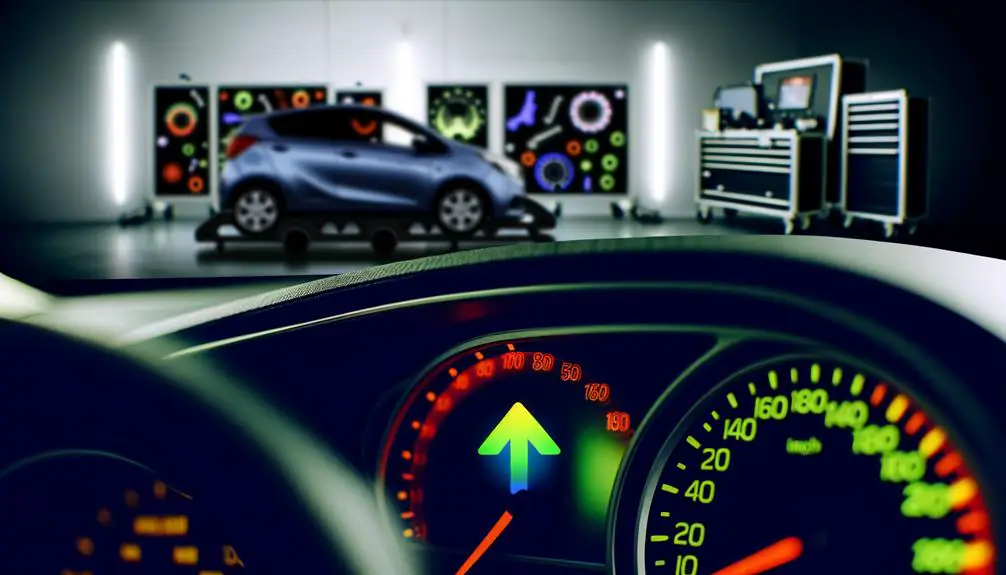
For accurate troubleshooting of the 'Car With Arrow' symbol, it is essential to acquaint yourself with common error codes associated with this warning.
Efficiently reading dashboard symbols and using necessary diagnostic tools such as OBD-II scanners can streamline the identification of underlying issues.
This approach enables a precise analysis and facilitates timely rectification of vehicle problems.
Common Error Codes
Diagnosing common error codes related to the car's arrow symbol requires an understanding of specific diagnostic trouble codes (DTCs) that can pinpoint the malfunction. Technicians utilize these DTCs to systematically identify and rectify issues, ensuring the vehicle's best performance.
Here are some prevalent DTCs associated with the arrow symbol:
- P0700: Transmission Control System Malfunction – Indicates a transmission-related issue requiring further investigation.
- P0730: Incorrect Gear Ratio – Suggests a problem within the transmission system affecting gear ratios.
- P0740: Torque Converter Clutch Circuit Malfunction – Points to possible faults in the torque converter clutch.
- P0750: Shift Solenoid A Malfunction – Reflects an issue with the shift solenoid, impacting gear shifting.
- P0765: Shift Solenoid D Malfunction – Indicates a malfunction in the shift solenoid D, affecting transmission operations.
Understanding these codes aids in accurate diagnosis and efficient repair.
Reading Dashboard Symbols
Comprehending and deciphering dashboard symbols, especially the arrow symbol, is a crucial step in diagnosing vehicle issues efficiently and effectively. The arrow symbol, often indicative of different system statuses, necessitates precise identification and contextual analysis.
For example, an arrow pointing upwards commonly signifies an issue with the cruise control system, while a circular arrow may pertain to the vehicle's stability control. Accurate symbol recognition assists in pinpointing potential malfunctions before they escalate. Analyzing the associated color—red, yellow, or green—provides further diagnostic clarity, with red indicating immediate attention and yellow suggesting caution.
Understanding these nuances ensures well-informed decision-making, thereby improving vehicle maintenance and operational safety. Proficiency in dashboard symbol interpretation is essential for any automotive diagnostic procedure.
Necessary Diagnostic Tools
An extensive diagnostic approach requires the use of advanced tools like OBD-II scanners, multimeters, and specialized software to accurately interpret vehicle data and identify underlying issues. These tools provide a detailed view of the vehicle's electronic systems, enabling professionals to pinpoint faults with precision.
Diagnostic efficiency is greatly improved when utilizing these tools, each serving a distinct purpose in the troubleshooting process.
- OBD-II Scanners: Extract diagnostic trouble codes (DTCs) for precise fault identification.
- Multimeters: Measure voltage, current, and resistance to assess electrical circuits.
- Specialized Software: Analyze vehicle-specific data for thorough diagnostics.
- Oscilloscopes: Visualize electrical signals to detect anomalies in sensor outputs.
- Thermal Imaging Cameras: Identify overheating components and potential thermal failures.
Using these tools is essential for an accurate and detailed diagnostic procedure.
Preventative Measures
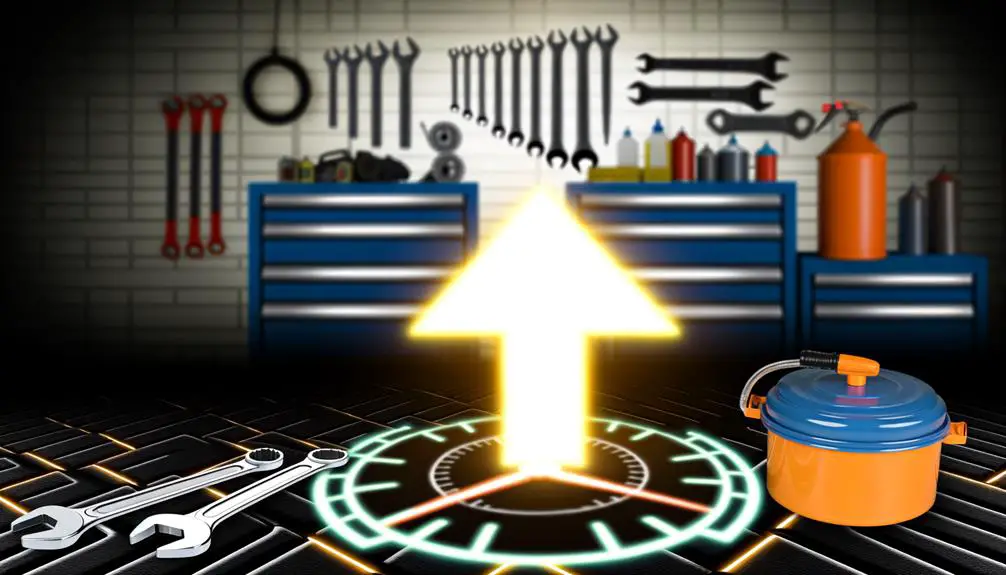
Implementing regular vehicle maintenance checks is crucial to prevent issues indicated by the car with arrow symbol. Rigorous adherence to scheduled inspections guarantees the early detection and rectification of potential malfunctions, thereby enhancing vehicle longevity and performance. Below is a table outlining key preventative measures:
| Preventative Measure | Frequency | Key Components Checked |
|---|---|---|
| Oil Change | Every 5,000 miles | Engine oil, oil filter |
| Tire Rotation | Every 6,000 miles | Tire tread, tire pressure |
| Brake Inspection | Every 10,000 miles | Brake pads, brake fluid |
| Battery Check | Annually | Battery charge, terminal corrosion |
| Fluid Levels Check | Monthly | Coolant, transmission fluid, wiper fluid |
Implementing these measures systematically will greatly reduce the risk of encountering warning symbols, ensuring optimal vehicle operation.
Professional Assistance
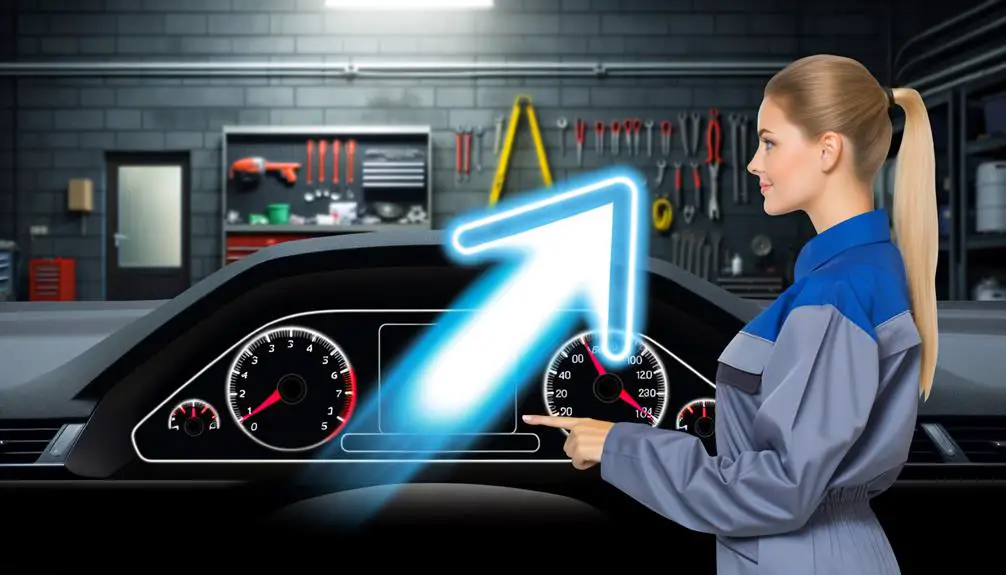
Seeking professional assistance is crucial when the car with an arrow symbol appears, as it often indicates complex issues that require diagnostic tools and specialized knowledge. Expert mechanics possess the necessary expertise to accurately diagnose and rectify underlying problems, safeguarding vehicle safety and performance.
- Diagnostic Equipment: Advanced tools to interpret error codes and conduct precise diagnostics.
- Technical Expertise: In-depth understanding of vehicle systems and components.
- Repair Precision: Ability to resolve specific issues without causing unintended damage.
- Software Updates: Capability to update vehicle software to address or prevent issues.
- Warranty Protection: Ensures repairs adhere to manufacturer guidelines, maintaining warranty validity.
Engaging professionals not only addresses immediate concerns but also prevents potential future failures, preserving the integrity and longevity of the vehicle.
Conclusion
To sum up, grasping the car with an arrow symbol is essential for upkeeping vehicle functionality and safety.
Identifying its potential causes, timely intervention, and using diagnostic measures can prevent more severe issues.
Proactive maintenance and seeking professional help when needed guarantee the vehicle stays in top-notch condition.
Disregarding this symbol could result in unnecessary complications, demonstrating that prevention is better than cure.
Implementing these approaches will protect both the vehicle and its occupants.






